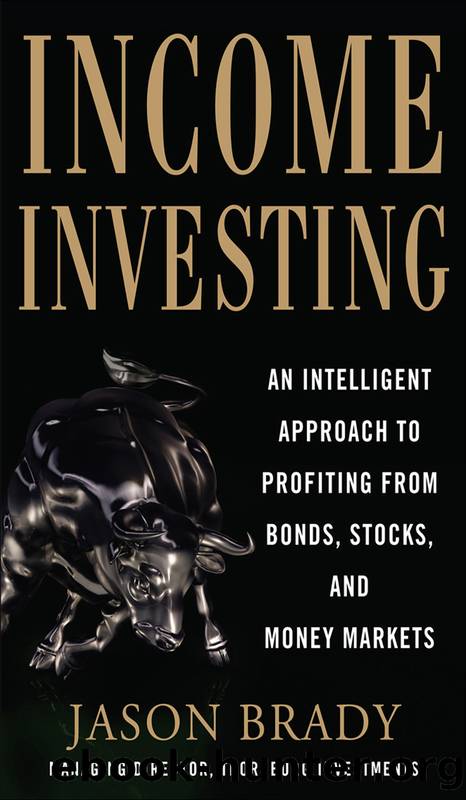Income Investing with Bonds, Stocks and Money Markets by Jason Brady

Author:Jason Brady
Language: eng
Format: epub
Publisher: McGraw-Hill Education
Published: 2012-03-14T16:00:00+00:00
FIGURE 4.2 Stocks and corporate bonds: bondholders have sold the upside option to stockholders.
To take a different asset class, MBSs (mortgage-backed securities) are an explicit example of the optionality present in fixed income. When a borrower takes out a mortgage in the U.S., the typical contract states that the borrower can refinance at any time. This means that when a homeowner with a mortgage needs to sell, he can sell his home and use the proceeds to pay off the mortgage debt, or a borrower can refinance that mortgage to a lower rate, even if he has no plans to move. Think about it from the lenderâs standpoint. If you lend someone money at 6 percent to buy a house, you are expecting to get a 6 percent return (yield) on that note. If rates go to 3 percent, however, the borrower will likely not keep paying that 6 percent mortgage. Instead, he will refinance with a lower 3 percent loan. Conversely, if rates go to 9 percent, the borrower will likely keep the 6 percent loan and count himself lucky to have it.
This works out badly for the lender in both cases. In the first case, the lender is expecting to get 6 percent, and instead, because the borrower has the option to prepay the mortgage, the lender suddenly receives all of its money back. But when the lender goes to reinvest, rates are no longer at 6 percent, but instead have moved to 3 percent, so the return is halved. In the case of rates moving higher, the lender has lent money at a 6 percent rate, and because there is little chance of a borrower paying back the debt early, the borrower is stuck with the 6 percent loan when the new price for similar risk is 9 percent. Think about what happens to the price of the mortgage. On one hand, if rates fall, the lender is likely to get its money back quickly, so the price of the mortgage is not going to move much above par. In addition, because the borrower is likely to get its money back quickly, the duration of the loan decreases dramatically. On the other hand, if rates rise, the lender is unlikely to get its money back very quickly, because the borrower will wait as long as possible to give up that great 6 percent rate in a 9 percent world. As a result, the duration of the bond will be longer and the price will fall fairly quickly. So mortgages rise less in a falling rate environment and fall more in a rising rate one. Itâs the worst of both worlds for the investor, and the way that the market makes up for this poor option profile is to demand a higher yield from the borrower.
So the optionality in the loan or in the bond (made up of a group of loans) has a dramatic effect on the duration of the bond and therefore also on the change in the bondâs price, given different interest rate moves.
Download
This site does not store any files on its server. We only index and link to content provided by other sites. Please contact the content providers to delete copyright contents if any and email us, we'll remove relevant links or contents immediately.
Rich Dad Poor Dad by Robert T. Kiyosaki(6185)
Pioneering Portfolio Management by David F. Swensen(6083)
How To Win Friends and Influence People by Dale Carnegie(4339)
The Money Culture by Michael Lewis(3850)
The Dhandho Investor by Mohnish Pabrai(3563)
The Wisdom of Finance by Mihir Desai(3528)
Liar's Poker by Michael Lewis(3228)
The Intelligent Investor by Benjamin Graham Jason Zweig(2934)
The ONE Thing by Gary Keller(2920)
Mastering Bitcoin: Programming the Open Blockchain by Andreas M. Antonopoulos(2894)
Fooled by Randomness: The Hidden Role of Chance in Life and in the Markets by Nassim Nicholas Taleb(2863)
Rich Dad Poor Dad: What The Rich Teach Their Kids About Money - That The Poor And Middle Class Do Not! by Robert T. Kiyosaki(2836)
Investing For Dummies by Eric Tyson(2797)
How to Win Friends and Influence People by Dale Carnegie(2796)
How to Day Trade for a Living: Tools, Tactics, Money Management, Discipline and Trading Psychology by Andrew Aziz(2786)
Market Wizards by Jack D. Schwager(2543)
Zero Hour by Harry S. Dent Jr. & Andrew Pancholi(2536)
How to Pay Zero Taxes, 2018 by Jeff A. Schnepper(2503)
Rich Dad's Guide to Investing by Robert T. Kiyosaki(2412)
